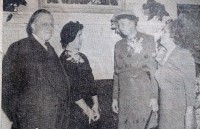Celebrating the 100-Year History of the Woman’s Club of White Plains Part 3 – The 1940’s

By Colleen Fay – 1940 started off with the country coming out of the depression, FDR elected to a third term, Europe in the midst of another major war and the U.S. desperately trying to stay out of it. The Contemporary Club, as it had done in the past, made its presence known in the community and continued to be involved in local, as well as national, issues. Many important events were marked during the decade of the 40’s, but most significantly, on December 21, 1948, the Contemporary Club officially became known as The Woman’s Club of White Plains. Ethel Kent was the first president.
In the late 30’s, the Club had been investigating the horrific conditions in the tenement housing on Winchester Street. After receiving a report by the Civic Committee, the city finally agreed to address the situation. The Club continued to call for the elimination of these buildings and the construction of affordable safe housing. Multiple newspaper articles highlighted the Club’s interest in the youth of White Plains and reported on a lecture the Club hosted on the need for programs for youth as a deterrent to crime. In 1941 the Club adopted a resolution which was sent to the NY State Senate calling for legislation “outlawing strikes in defense industries” and to “purge Communists, Nazis and Fascists from Federal payrolls”.
Various programs on political, social and educational topics were presented at Club Day. Professors from local universities including NYU were invited to speak. Classes in “home defense” were offered by the Civic Committee. The Contemporary Club hosted a lecture at White Plains High School by Admiral Richard E. Byrd of Antarctica fame.
Although day-to-day life for most of 1940-41 had not been significantly affected by the war in Europe, the women at the Club were not immune to the suffering overseas. Prior to U.S. involvement in WWII, the women of the Contemporary Club had knitted 250 lbs. of yarn into socks, mufflers and scarves for the Red Cross. They were also involved in Bundles for Britain and the French War Relief. After Pearl Harbor, the women really kicked into high gear and the focus of the club during this time was mainly on supporting the local war effort.
In early 1942, the Victory Committee was formed which was in charge of classes in home defense, first aid, home nursing and salvage. The Disaster Closet was created. A Red Cross fundraiser known as the Dessert Party was attended by 1300 people. There were 130 tables of bridge in the afternoon and 75 more in the evening. The auditorium was designated an official first aid station. The club made a canvass of its roster for war time service: 311 registered for various types of work including 23 for “motor driving”, 10 clerical work, 4 physicians, 31 nursing, 13 camp cooking, 2 police duty, 28 knitting and 6 for public service including gas and electric inspectors and trolley car conductors. Club members also donated gifts to convalescent veterans.
Once the war ended, the Club got back to normal operations and hosted many notable speakers. The most famous person ever to speak at the Woman’s Club was Eleanor Roosevelt. On November 3, 1949 she appeared at the Woman’s Club with Clark M. Eichelberger, director of the American Association for the United Nations. Mrs. Roosevelt lectured on the “Responsibilities of World Citizenship.” To an audience of 600 women she declared, “Whether democracy wins or loses is decided here in White Plains and in every other community.”
The Thrift Shop, which had been in operation for over 20 years, continued its philanthropic focus. During the war, club members were reminded that, while clothing donations to overseas relief organizations were admirable, they should not neglect the needy in their local communities. The Annual Doll Fair sponsored by the Thrift Shop continued. White Plains Hospital was a frequent recipient of donations, in 1949 receiving $3000 towards its building fund. Benefit Bridges were also held to raise money. Between 1946 and 1948, two nursing scholarships of $300 were awarded; $300 was donated to children of Lorient, France and $500 to YWCA.
Toward the end of 1949, the Club undertook a general refurbishing and renovating of the Clubhouse. It was at this time that the beautiful murals in the dining room were discovered under layers of thick shellac. The murals, which date from the 1800’s, were valued at that time at $48,000.

Examiner Media – Keeping you informed with professionally-reported local news, features, and sports coverage.
